#finnish architects
Explore tagged Tumblr posts
Text







Jätkäsaari Comprehensive School, Helsinki - AOR Architects
#AOR Architects#architecture#design#building#modern architecture#interiors#minimal#modern#concrete#school#school design#cool architecture#beautiful buildings#cool design#education#secondary school#playground#atrium#staircase#facade#brick#concrete architecture#light#finland#finnish#architecture blog#architectural#architectural photography#urban#helsinki
65 notes
·
View notes
Text
if I could resurrect one person, it'd be Alvar Aalto and just so I could kick his ass
#alvar aalto was a finnish architect#who designed a shit ton of fuck ass buildings rotting all over this fucking country#most of which are the least accessible buildings ever made and ofc are public places#anyway#he was a pretty big deal tho and even tho most of his building are fucking shit to use this country does its absolute best to preserve them#and this guy#designed himself a fucking boat#and called it Nemo propheta in patria#fuck you alvar aalto i'm going to piss on your grave
12 notes
·
View notes
Photo

5 notes
·
View notes
Text
Im in the long process of watching Grian's world tour video-
And I think this is the first time I've really ever "met" Joehills. I've known he was a member of the server for a long time, and that in the fanart he is a muppet (????), but I've never really seen him or listened to him speak before.
My god, he is WAY MORE casually unhinged than I EVER could have predicted.
"Oh yeah, here's a build that's so large I'm afraid I'll lose ya Grian if you wander off, but guess what? This isn't even the actual build! It's ONE EIGHTH of my actual overworld build that is SO ENORMOUS that you can't fit it on a map of the server 😊"
"This is a representation of Finnish American architect (Insert the name he said because I have no clue how to spell that 💀) vision for the bell laboratory's research and development campus-" *continues to adorably ramble all nerd like*
"Yeah, so because they did that, I basically filled their backyard with approximately 1.5 million stone over the course of the last 5 weeks :p"

8K notes
·
View notes
Text
BERNARD VENET NAMED THIS CORTEN STEEL SCULPTURE AS 217.5º ARC x 12 - VIDEO
Video: Bernar Venet (born 21 April 1941) is a French Conceptual artist who has exhibited his works in various locations around the world.
MUSEUM OF MODERN ART DUBLIN Bernar Venet (born 21 April 1941) is a French Conceptual artist who has exhibited his works in various locations around the world. Weathering steel, best-known under the trademark COR-TEN steel and sometimes written without the hyphen as “Corten steel”, is a group of steel alloys which were developed to eliminate the need for painting, and form a stable rust-like…

View On WordPress
#Bernar Venet#COR-TEN steel#Corten Steel#December 2023#DJI#Eero Saarinen#Finnish-American architect#Fotonique#French Conceptual artist#Illinois#Infomatique#irish museum of modern art#John Deere headquarters in Moline#Pocket 3#Sculpture#William Murphy
0 notes
Text
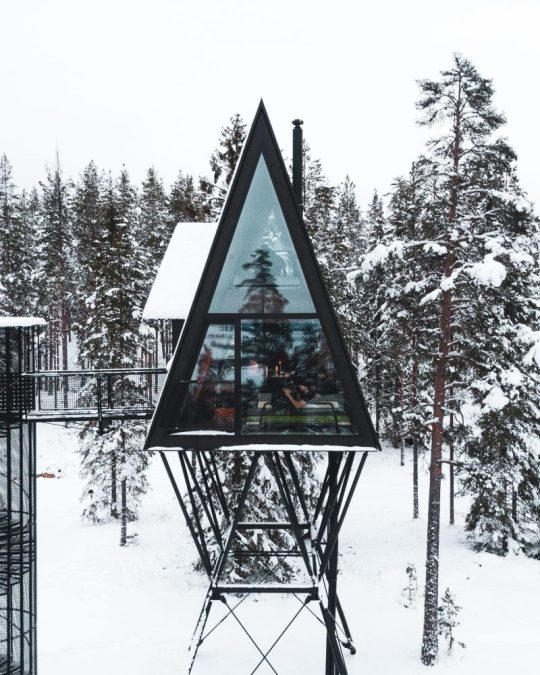
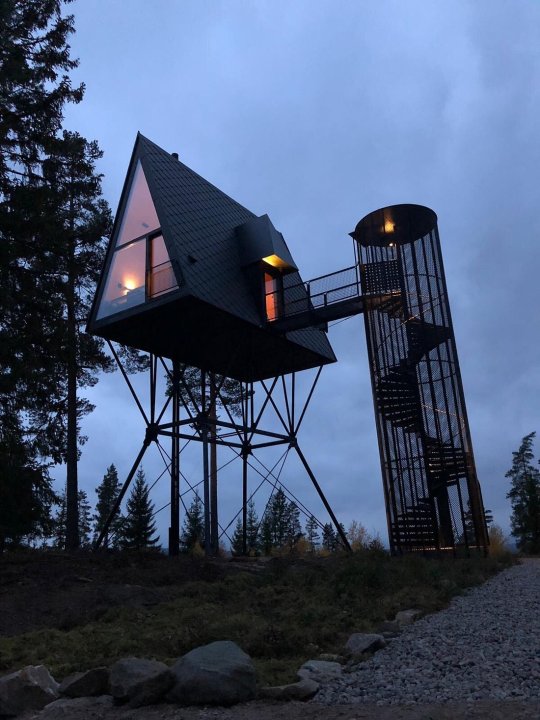
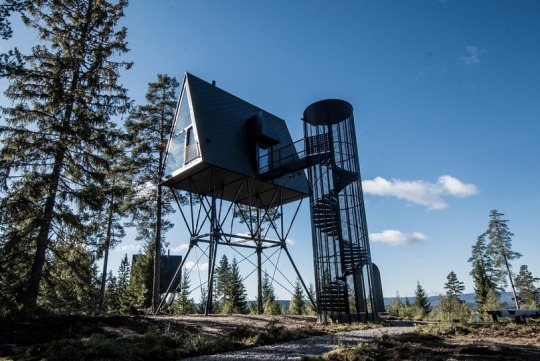
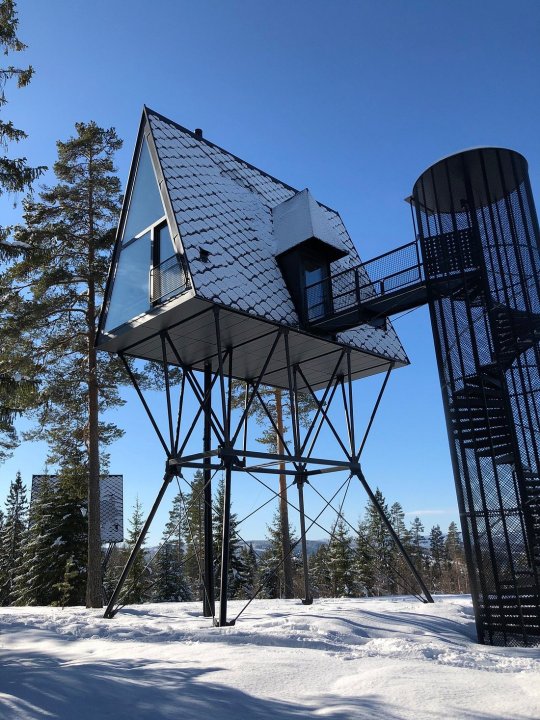
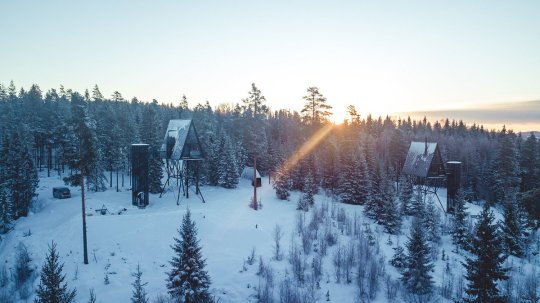
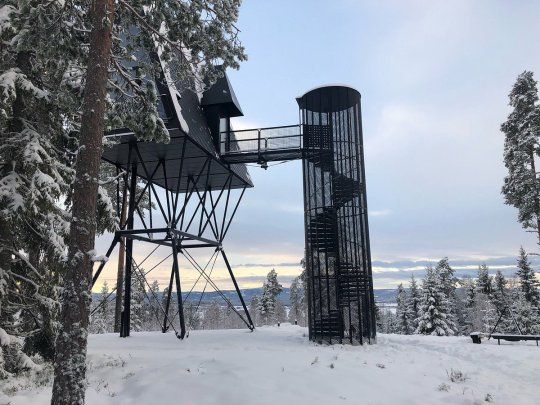









PAN TREETOP CABINS - АРХИТЕКТУРА ДЛЯ СОЗЕРЦАНИЯ ПРИРОДЫ.
Отель PAN Treetop Cabins, созданный архитектором Эспеном Сурневиком, находится в норвежском лесу и идеально подходит для сказочного отдыха.
Дома-Шалаши, принадлежащие Кристиану Ростаду и Кристине Мовинкель, расположены на высоте 8 метров над землей на стальных опорах, погруженных на 6 метров в скальную породу, что обеспечивает устойчивость при сильном ветре. Сурневик, который также является профессором Школы архитектуры Осло, черпал вдохновение в этом регионе, в частности, в комиксе финской художницы Туве Янссон с изображением сказочных персонажей по имени Муми-тролли. «Для меня это подлинное ощущение того, как нордический человек относится к большим расстояниям между поселениями в сельской Скандинавии, одиночеству, темным зимам и холодному климату».
Второй источник его вдохновения, очевидный в дизайне винтовой лестницы, ведущей в хижину, - это пожарная смотровая башня, которая, по словам Сурневика, является частью ландшафта в лесной полосе, окружающей северное полушарие. «Эти пожарные вышки построены так, чтобы в засушливые сезоны смотреть на огромные леса в поисках дыма и огня», - говорит он.
Архитектор Эспен Сурневик выбрал американскую типологию лоджа с А-образной рамой, потому что он «одновременно интимный по ширине и монументальный по высоте, и представляет собой нечто базовое в своей треугольной форме».
Наружная облицовка зданий из черного оксидированного цинка и стали помогает им сливаться с окружающим лесом. Каждый дом шалаш имеет внутреннее пространство длиной 9,5 м, высотой 5,5 футов и шириной 3,6 и может с комфортом разместить до шести человек. Уютная гостиная, мягкое настенное освещение и светлый пол из твердых пород дерева Энергоэффективные А-образные дома-шалаши обращены к солнцу и имеют большие застекленные фасады, пропускающие свет и тепло.
Для отдыха в домике есть антресоль с двуспальной кроватью, дополнительные спальные зоны, скрытые во внутренних стенах, небольшую кухоньку и камин, а также ванную комнату с туалетом и душем.Интерьеры облицованы сосновой доской, а текстиль в домах сделан из 100% местной шерсти. В качестве отопления есть дровяной камин и деревянные полы со встроенным электрическим отоплением. Из окон спального лофта открывается вид на верхушки деревьев.
«Мое видение состояло в том, чтобы создать что-то, что легко вписалось бы в ландшафт, не внося больших изменений в окружающую природу...» - говорит Сурневик.
PAN TREETOP CABINS - ARCHITECTURE FOR CONTEMPLATION OF NATURE.
The PAN Treetop Cabins by architect Espen Surnevik are located in a Norwegian forest and are ideal for a fairytale getaway.
The Treetop Cabins by Christian Rostad and Christina Mowinckel are located 8 metres above the ground on steel supports sunk 6 metres into the rock, ensuring stability in strong winds. Surnevik, who is also a professor at the Oslo School of Architecture, drew inspiration from the region, in particular from Finnish artist Tove Jansson's comic strip featuring the Moomins. "For me, it's an authentic feeling of how Nordic people deal with the long distances between settlements in rural Scandinavia, the loneliness, the dark winters and the cold climate."
His second source of inspiration, evident in the design of the spiral staircase leading up to the cabin, is a fire lookout tower, which Surnevik says is part of the landscape in the forest belt that surrounds the northern hemisphere. “These fire lookout towers are built to look out over the vast forests in dry seasons for smoke and fire,” he says.
Architect Espen Surnevik chose the American A-frame lodge typology because it is “both intimate in width and monumental in height, and represents something basic in its triangular form.”
The buildings’ exterior cladding of black oxidized zinc and steel helps them blend into the surrounding forest. Each cabin has an interior space measuring 32 feet long, 18 feet high and 12 feet wide, and can comfortably accommodate up to six people. Cozy living room, soft wall lighting and light hardwood floors The energy-efficient A-frame houses face the sun and have large glazed facades that let in light and warmth.
For relaxation, the house has a loft with a double bed, additional sleeping areas hidden in the internal walls, a small kitchenette and a fireplace, as well as a bathroom with a toilet and shower. The interiors are lined with pine boards, and the textiles in the houses are made from 100% local wool. For heating, there is a wood-burning fireplace and wooden floors with built-in electric heating. The sleeping loft has a view of the treetops.
“My vision was to create something that would easily fit into the landscape without making big changes to the surrounding nature…” says Surnevik.
Источник://www.tripadvisor.co.uk/Hotel_Review-g3592302-d15293006-Reviews-PAN_Treetop_Cabins-Flisa_Asnes_ Municipality_Hedmark_Eastern_Norway.html/truestory.no/norges-20-fineste-tretopphytter/, //www.architime.ru/news /espen_ surnevik / pan_treetop_cabins.htm#13.jpg, //udom-spb.ru/articles/treugolnyy-dom-shalash-a-frame-kupit.
#Norway#nature#tourism#Architecture#PAN Treetop Cabins#architect#Espen Surnevik#interior design#landscape photography#nature aesthetic#landscape#trees and forests#winter forest#photography#Норвегия#приро��а#туризм#Дома-Шалаши#архитектура#архитектор#Эспен Сурневик#Пейзаж#природнаякрасота#горы и лес#зимний лес#пейзаж#дизайн интерьера#фотография
159 notes
·
View notes
Text
ok so a little yap about grians tour vid (which i finally watched guys who's proud of me and it was really fun) so my main povs are usually like grian, scar, etho, pearl, and mumbo, and i don't even watch all of them regularly. anyway i really appreciated seeing other people and i discovered a bunch of hermits who were really sweet and i lowkey loved? like joe??
this guy was so freaking sweet? like i have never watched his vids at all but when grian went over to his base and he was talking about how his base is based on the work of this finnish architect and then proceeded to nerd out about it for like 30 seconds. SIR?? YOU'RE SO ADORABLE!! and then he was like oh grian if you ever need any space you know where to find me. Idk man but this little guy is so cute and i cant beleive i didn't know about him. so anyway thanks grian for introducing me to the hermits and uhm yeah lets appreciate less popular hermits because they're super awsome!!
35 notes
·
View notes
Note
About the SOK mill. You probably tag posts by today's borders. But for information in 1932 (when the picture was taken) Vyborg was finnish town and Erkki Huttunen was a finnish architect. There are similar buildings in Finland.
Indeed, I'm following current borders, but historically speaking it's a Finnish building, so I added Finland to the tags.
14 notes
·
View notes
Text
Did you guys know the author of Moomin is a finnish woman who is also the partner of Tuulikki Pietilä, who is an artist and sister to architect Reima Pietilä who designed a summer cottage for the couple with his wife (Raili Pietilä) which was the inspiration for the Moomins?
10 notes
·
View notes
Text

Milwaukee's War Memorial & Arts Center was designed in the early 1950s by Finnish-American architect Eero Saarinen. The concrete, glass and steel building sits on angular, reinforced columns and offers spectacular views of Lake Michigan. (Photographer unknown) #saarinen #milwaukee #midcenturymodern
27 notes
·
View notes
Note
Hey totally-official-VR! Can you tell us anything cool about the railway station in Loimaa? I hear the building is of a crop of station buildings that's rather rare to find these days :)
Hi totally-unknown-anon! The Loimaa station is indeed an interesting one, and certainly rare enough for Museovirasto (the Finnish Heritage Agency) to have listed it as a nationally important building.

Street facade. TeVe, Wikimedia Commons.
So. The Loimaa station is one of the original surviving stations of the Toijala–Turku line, built in 1876. It's also one of the numerous station built for operational reasons: the location, near the bridge passing Loimijoki, was approximately at the halfway point of the railway. Thus, despite being built in the middle of a forest, the Loimijoki station (as it was originally know) was the only III class station on the line (Turku and Toijala were II class, all others were IV or V class).

Platform facade. Mikkoau, Wikimedia Commons.
The station building is again likely designed by Knut Nylander, who was VR's in-house architect at the time, but the plans are unsigned. Somewhat unusually for the time, the plans are unique; usually Nylander and his successors produced type drawings that were copied for numerous stations along the same line and even across different lines to save costs. The Loimaa station was a one-off, and in the Renaissance revival style that was typical of Nylander's later work for the Pohjanmaa line, but contrasted with the other stations of the Toijala–Turku and Hämeenlinna–Tampere lines (which were built simultaneously). To my eye the station also has some similarity to the long since demolished old stations of Lahti and Viipuri, but of course I'm just an enthusiastic amateur.
Also somewhat unusually, the Loimaa station remains largely unaltered from the original; commonly, stations were built with a minimal budget and needed to be expanded later on, but this was never necessary for Loimaa.

An undated view of the station area, presumably from the late 1960s or the 1970s. The station itself to the left, behind the Dm7 railbuses and Dm9 fast train unit. Next to it is the freight station. Suomen rautatiemuseo.
After construction of the station, a town quickly sprung up around it, becoming the most important centre of the area and it is today the administrative centre of the Loimaa municipality.
Had history played out differently, Loimaa could have become a major intersection station, as from the late 1800s until the 1950s there were plans to build a direct line from Helsinki to Pori, which would have crossed the Toijala–Turku line at Loimaa. From the point of view of architecture it's perhaps a good thing this didn't happen, as a major elevation in status for Loimaa would have probably resulted in the station building being torn down and replaced by a larger one.
43 notes
·
View notes
Text




'Jumbo' lounge chair by Olof Ottel,
Originally designed by Finnish interior architect Olof Ottelin in 1958,
Oak, W 72 cm, H 69 cm, D 76 cm,
Courtesy: Fasetti
#art#design#sculpture#furniture#minimal#seat#chair#forms#jumbo#olof ottel#fasetti#millwork#finland#mid century modern#mid century#iconic
62 notes
·
View notes
Text
Finland is seeing college-educated people out of work in sectors where joblessness hasn't been typical, reports Kauppalehti.
The business daily said academic unemployment is nearing a ten-year high, with some 47,000 university graduates now job searching.
The economic slowdown is particularly hitting the technology and construction sectors. At the end of last year, ten percent of architect union members were drawing unemployment benefits.
KL also noted that even the IT services sector is sluggish, which is highly unusual.
Last week news emerged that PhD holders were struggling to find employment. There are currently 1,400 unemployed PhDs in Finland, two-thirds of whom are classed as long-term unemployed.
Snooping private records
Individuals' information in Finland is relatively easy to come by legally — the country is renowned for its tax data transparency, after all.
Hufvudtsdabladet, however, reports on curious dental hygienists who accessed patient records without a legitimate reason.
A Helsinki City dental hygienist accessed the records of over 2,000 individuals without authorisation. Another four dental care staff looked up the information of some 1,000 people.
All those involved in the unauthorised access have been dismissed, according to the paper.
Warming winters
This week has seen reports of föhn winds warming conditions in Finland to such an extent that snow cover will melt completely in large parts of the southwest and west of the country.
Maaseudun Tulevaisuus says temperatures will reach seven degrees Celsius in the south on Thursday while remaining well above freezing elsewhere in the country.
Finnish winters are seeing variable conditions. Last year, temperatures in Finland were on average 3.4 degrees warmer than in the pre-industrial era, with 2024 being the fourth warmest year on record.
#nunyas news#updates from up north#some of those job numbers will shift back#when they kill the ai stuff I'd wager
3 notes
·
View notes
Text



Image sources (L to R): 1, 2, 3
this is some design nerd¹ shit, but, okay, i was on the stüssy website, which, yes, i'm probably too old for at this point, but like, i'm in the market for baggy pants, i go where the call of the baggy pants takes me—anyway, their new arrivals include the central vase above, which is already a little weird because fundamentally they're, like, a skatewear brand, right? but i took one look at it and went, huh, that looks awfully familiar; and like, look at the vases on the left and right, above: i think you'd be hard-pressed to argue it wasn't, shall we say, in dialogue with them!
which is mostly wild because like. those are vases designed by finnish architect alvar aalto almost ninety years ago, how in the world did we get from there to here! i guess it's like, stüssy started out selling orange county surfwear, and aalto is finnish for wave??? anyway. hashtag web weaving or something—


Image sources: L, R
⸻ ¹ design nerd is an exaggeration, those aalto vases are, like, the opposite of obscure and i don't want you thinking i'm claiming otherwise. however.
47 notes
·
View notes
Text
Oooh yiss more music tag games!! Thank you for the tag @sleebyvessel and @reveries-of-my-mind 💖
Ten songs I’ve enjoyed recently:
I'm tagging but as always no pressure feel free to skip: @moonchild-in-blue @thejawsoffate @takemetoasgard @tonguetyd @madsthenightowl @fivewholeminutes @foundationsofdecay @the--vessel @leonsleftbicep @polteergeistt i know i know.. i never remember who to tag, i'm sorry if i tagged you before and now i forgot i still love you i'm just stupid
Also pleasepleaseplease do consider yourself tagged by me without hesitation! I love these music based games because i frequently find cool new stuff i had never even heard of before.
Also putting it under the cut, because i'm gonna talk a bit about some of them as well not just list them
The links go to spotify The entire list could be Sleep Token but i'm forgoing it because i listen to different stuff besides it a lot, so have some cherry picked form my recent on repeat stuff:
XII: Frälsare by Dygn (But i can honestly recommend the album in it's entirety. It is instrumental. I'd say some sort of experimental atmospheric tech metal sort of whatever with heavier and ambient parts following one and other but it is so so so good. I only found it a month or so back i think but i'm hooked.)
Shanghai by Darko US (Look i love ridiculously heavy and stupid stuff and Darko is exactly that. DISCLAIMER: If you ever check this out on YT the video's trigger warning on the imagery in the beginning is not a joke, take it seriously)
An Awakening of Revenants by A Black Rose Burial (An oldie but a goodie and i'll die on that hill. A friend of mine showed me way back when we were kids and we listened the shit out of it. I'm definitely on a nostalgia train with this)
Seeing Red by Architects (This kinda speaks for itself. I love metal core, always has always will)
Higher by Sleep Token (I listen to this song a stupid amount there is no two ways about that.)
Herald of Darkness by Old Gods of Asgard from Alan Wake II (I love my finnish sadboys -i know they are pushing or already over 50 what of it- in Poets of the Fall a lot no matter what they do. And if what they do is a poprock musical song in yet another great game i'm not gonna complain. And to be fair the tamber of Marko's voice is very dear to my heart.)
Break Shins to This by Rabbit Junk (I don't have an answer for this. I love weird stuff and Rabbit Junk's industrial tech post hardcore metal pop drum&bass whatever the fuck is their blend is just so fucking good)
Light Up the Sky by The Prodigy (Prodigy is so good when you have to do stuff. No matter what.)
Inhumane by Polaris (I don't really have much input here, besides i like heavy music and i just love the entirety of Fatalism)
parasite by thrown (Same, i like heavy music)
14 notes
·
View notes
Text
Across a sterile white table in a windowless room, I’m introduced to a woman in her forties. She has a square jaw and blonde hair that has been pulled back from her face with a baby-blue scrunchie. “The girls call me Marmalade,” she says, inviting me to use her prison nickname. Early on a Wednesday morning, Marmalade is here, in a Finnish prison, to demonstrate a new type of prison labor.
The table is bare except for a small plastic bottle of water and an HP laptop. During three-hour shifts, for which she’s paid €1.54 ($1.67) an hour, the laptop is programmed to show Marmalade short chunks of text about real estate and then ask her yes or no questions about what she’s just read. One question asks: “is the previous paragraph referring to a real estate decision, rather than an application?”
“It’s a little boring,” Marmalade shrugs. She’s also not entirely sure of the purpose of this exercise. Maybe she is helping to create a customer service chatbot, she muses.
In fact, she is training a large language model owned by Metroc, a Finnish startup that has created a search engine designed to help construction companies find newly approved building projects. To do that, Metroc needs data labelers to help its models understand clues from news articles and municipality documents about upcoming building projects. The AI has to be able to tell the difference between a hospital project that has already commissioned an architect or a window fitter, for example, and projects that might still be hiring.
Around the world, millions of so-called “clickworkers” train artificial intelligence models, teaching machines the difference between pedestrians and palm trees, or what combination of words describe violence or sexual abuse. Usually these workers are stationed in the global south, where wages are cheap. OpenAI, for example, uses an outsourcing firm that employs clickworkers in Kenya, Uganda, and India. That arrangement works for American companies, operating in the world’s most widely spoken language, English. But there are not a lot of people in the global south who speak Finnish.
That’s why Metroc turned to prison labor. The company gets cheap, Finnish-speaking workers, while the prison system can offer inmates employment that, it says, prepares them for the digital world of work after their release. Using prisoners to train AI creates uneasy parallels with the kind of low-paid and sometimes exploitive labor that has often existed downstream in technology. But in Finland, the project has received widespread support.
“There's this global idea of what data labor is. And then there's what happens in Finland, which is very different if you look at it closely,” says Tuukka Lehtiniemi, a researcher at the University of Helsinki, who has been studying data labor in Finnish prisons.
For four months, Marmalade has lived here, in Hämeenlinna prison. The building is modern, with big windows. Colorful artwork tries to enforce a sense of cheeriness on otherwise empty corridors. If it wasn’t for the heavy gray security doors blocking every entry and exit, these rooms could easily belong to a particularly soulless school or university complex.
Finland might be famous for its open prisons—where inmates can work or study in nearby towns—but this is not one of them. Instead, Hämeenlinna is the country’s highest-security institution housing exclusively female inmates. Marmalade has been sentenced to six years. Under privacy rules set by the prison, WIRED is not able to publish Marmalade’s real name, exact age, or any other information that could be used to identify her. But in a country where prisoners serving life terms can apply to be released after 12 years, six years is a heavy sentence. And like the other 100 inmates who live here, she is not allowed to leave.
When Marmalade first arrived, she would watch the other women get up and go to work each morning: they could volunteer to clean, do laundry, or sew their own clothes. And for a six hour shift, they would receive roughly €6 ($6.50). But Marmalade couldn’t bear to take part. “I would find it very tiring,” she says. Instead she was spending long stretches of time in her cell. When a prison counselor suggested she try “AI work,” the short, three-hour shifts appealed to her, and the money was better than nothing. “Even though it’s not a lot, it’s better than staying in the cell,” she says” She’s only done three shifts so far, but already she feels a sense of achievement.
This is one of three Finnish prisons where inmates can volunteer to earn money through data labor. In each one, there are three laptops set up for inmates to take part in this AI work. There are no targets. Inmates are paid by the hour, not by their work’s speed or quality. In Hämeenlinna, around 20 inmates have tried it out, says Minna Inkinen, a prison work instructor, with cropped red hair, who sits alongside Marmalade as we talk. “Some definitely like it more than others”. When I arrive at the prison on a Wednesday morning, the sewing room is already busy. Inmates are huddled over sewing machines or conferring in pairs over mounds of fabric. But the small room where the AI work takes place is entirely empty until Marmalade arrives. There are only three inmates in total who regularly volunteer for AI shifts, Inkinen says, explaining that the other two are currently in court. “I would prefer to do it in a group,” says Marmalade, adding that she keeps the door open so she can chat with the people sewing next door, in between answering questions.
Those questions have been manually written in an office 100 kilometers south of the prison, in a slick Helsinki coworking space. Here, I meet Metroc’s tall and boyish founder and CEO, Jussi Virnala. He leads me to a stiflingly hot phone booth, past a row of indoor swings, a pool table, and a series of men in suits. It’s an exciting week, he explains, with a grin. The company has just announced a €2 million ($2.1 million) funding round which he plans to use to expand across the Nordics. The investors he spoke with were intrigued by the company’s connection to Finland’s prisons, he says. “Everyone was just interested in and excited about what an innovative way to do it,” says Virnala. “I think it’s been really valuable product-wise.”
It was Virnala’s idea to turn to the prisons for labor. The company needed native Finnish speakers to help improve its large language model’s understanding of the construction-specific language. But in a high-wage economy like Finland, finding those data laborers was difficult. The Finnish welfare system’s generous unemployment benefits leaves little incentive for Finns to sign up to low-wage clickwork platforms like Amazon’s Mechanical Turk. “Mechanical Turk didn’t have many Finnish-language workers,” says Virnala. At the same time, he adds, automatic translation tools are still no good at Finnish, a language with only 5 million native speakers.
When Virnala pitched his idea to Pia Puolakka, head of the Smart Prison Project at Finland’s prison and probation agency, she was instantly interested, she says. Before the pandemic, another Finnish tech company called Vainu had been using prisoners for data labor. But Vainu abruptly pulled out after a disagreement between cofounders prompted Tuomas Rasila, who had been in charge of the project, to leave the company.
By the time Virnala approached her with his proposal in 2022, Puolakka was eager to resurrect the AI work. Her job is to try and make the relationship between Finnish prisons and the internet more closely resemble the increasingly digital outside world. So far, she has been installing laptops in individual cells so inmates can browse a restricted list of websites and apply for permission to make video calls. She considers data labor just another part of that mission.
The aim is not to replace traditional prison labor, such as making road signs or gardening. It’s about giving prisoners more variety. Data labeling can only be done in three-hour shifts. “It might be tiring to do this eight hours a day, only this type of work,” she says, adding that it would be nice if inmates did the data labeling alongside other types of prison labor. “This type of work is the future, and if we want to prepare prisoners for life outside prison, a life without crime, these types of skills might be at least as important as the traditional work types that prisons provide,” she says.
But how much data labeling offers inmates skills that are transferable to work after prison is unclear. Tuomas Rasila, the now estranged cofounder of Vainu, who managed the prison project there for a year, admits he has no evidence of this; the project wasn’t running for long enough to collect it, he says. “I think asking people, who might feel outside of society, to train the most high-tech aspect of a modern society is an empowering idea.”
However, others consider this new form of prison labor part of a problematic rush for cheap labor that underpins the AI revolution. “The narrative that we are moving towards a fully automated society that is more convenient and more efficient tends to obscure the fact that there are actual human people powering a lot of these systems,” says Amos Toh, a senior researcher focusing on artificial intelligence at Human Rights Watch.
For Toh, the accelerating search for so-called clickworkers has created a trend where companies are increasingly turning to groups of people who have few other options: refugees, populations in countries gripped by economic crisis—and now prisoners.
“This dynamic is a deeply familiar one,” says Toh. “What we are seeing here is part of a broader phenomenon where the labor behind building tech is being outsourced to workers that toil in potentially exploitative working conditions.”
Toh is also skeptical about whether data labor can help inmates build digital skills. “There are many ways in which people in prison can advance themselves, like getting certificates and taking part in advanced education,” he says. “But I'm skeptical about whether doing data labeling for a company at one euro per hour will lead to meaningful advancement.” Hämeenlinna prison does offer inmates online courses in AI, but Marmalade sits blank-faced as staff try to explain its benefits.
Science
Your weekly roundup of the best stories on health care, the climate crisis, genetic engineering, robotics, space, and more. Delivered on Wednesdays.
By the time I meet Lehtiniemi, the researcher from Helsinki University, I’m feeling torn about the merits of the prison project. Traveling straight from the prison, where women worked for €1.54 an hour, to Metroc’s offices, where the company was celebrating a €2 million funding round, felt jarring. In a café, opposite the grand, domed Helsinki cathedral, Lehtiniemi patiently listens to me describe that feeling.
But Lehtiniemi’s own interviews with inmates have given him a different view—he’s generally positive about the project. On my point about pay disparity, he argues this is not an ordinary workforce in mainstream society. These people are in prison. “Comparing the money I get as a researcher and what the prisoner gets for their prison labor, it doesn't make sense,” he says. “The only negative thing I’ve heard has been that there’s not enough of this work. Only a few people can do it,” he says, referring to the limit of three laptops per prison.
“When we think about data labor, we tend to think about Mechanical Turk, people in the global south or the rural US,” he says. But for him, this is a distinct local version of data labor, which comes with a twist that benefits society. It’s giving prisoners cognitively stimulating work—compared to other prison labor options—while also representing the Finnish language in the AI revolution.
Without this kind of initiative, Lehtiniemi worries that non-English languages are being locked out of this next generation of technology. Smart speakers still struggle to understand Finnish dialects. “Not all Finnish people speak English very well, so there's a need for these local forms of data labeling as well,” Lehtiniemi says. Metroc isn’t the only company that has been forced to get creative about finding Finnish data labor. In 2011, the national library created a game to incentivize volunteers to help digitize its archive. In 2020, broadcaster YLE teamed up with Helsinki University and the state development company VAKE to ask volunteers to donate recordings of them speaking Finnish.
There is a sense in Finland that the prison project is just the beginning. Some are worried it could set a precedent that could introduce more controversial types of data labeling, like moderating violent content, to prisons. “Even if the data being labeled in Finland is uncontroversial right now, we have to think about the precedent it sets,” says Toh. “What stops companies from outsourcing data labeling of traumatic and unsavory content to people in prison, especially if they see this as an untapped labor pool?”
It's also not clear whether labor conditions in Finland's prisons—which famously focus on rehabilitation—could be replicated in other countries with a less progressive approach to justice. In the US, 76 percent of prisoners report that prison labor is mandatory, according to civil rights group, the ACLU. “The prison system in the United States is very, very different from what we have in Finland or Nordic countries. It's a completely different idea,” says Rasila. “In Finland, there is an exclusively positive feeling around the project because everyone knows that this is very voluntary.”
AI companies are only going to need more data labor, forcing them to keep seeking out increasingly unusual labor forces to keep pace. As Metroc plots its expansion across the Nordics and into languages other than Finnish, Virnala is considering whether to expand the prison labor project to other countries. “It’s something we need to explore,” he says.
25 notes
·
View notes